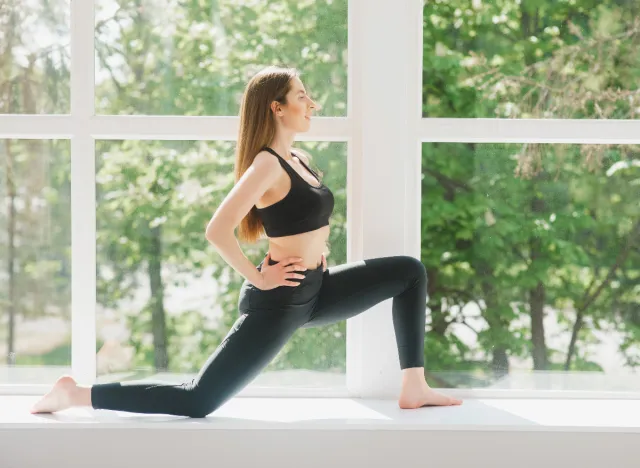Is Sitting Giving You ‘Flat Butt’? Here’s How To Fix It

To be all-around healthy and happy, it’s so important to stay active. In fact, did you know that sitting on the couch or at your desk too long and too often can even cause your butt to look flatter? You heard that right! The result is referred to as “flat butt”, or “dormant butt syndrome.”
To deal with this frustrating body challenge, Mike Bohl, MD, MPH, ALM, the Director of Medical Content & Education at Ro and a member of the Eat This, Not That! Medical Expert Board, explains that the path to having a flat butt has some misconceptions. He reveals, “the actual weight of sitting on your butt isn’t what impacts its shape—but the overall physical inactivity is.”
So if you want some shape to your derrière, stand up, get moving, and listen up! Keep reading to learn more, and next, check out 6 Exercises You Need To Do Regularly in Your 60s To Stay in Shape.
What causes a flat butt?

It goes a little something like this. Living a sedentary lifestyle promotes two challenges, Dr. Bohl explains. “First, you’re not using the gluteal muscles, so they can start to atrophy and get smaller. And second, by staying in a seated position in which your thighs are at a right angle with your torso, your hip flexors—the muscles that normally help pull the legs forward—tighten. This causes a muscle imbalance that can affect your posture and makes it so the muscles aren’t working as efficiently as they could. This, combined with the smaller gluteal muscles, can give you the appearance of having a ‘flat butt.'”
Now that you know the cause, let’s chat about damage control. These are the most effective ways to deal with “flat butt.”
Add more activity throughout your day.
Working at a desk all day long makes it incredibly difficult to not sit. One step to lower the risk of a flat backside is to opt for a standing desk. You can also purchase an under-desk treadmill so you can reap the benefits of getting in some steps, while you’re at it. In addition, take timed breaks!
Dr. Bohl recommends, “Get up and walk around once or twice an hour. As an added bonus, taking short breaks like this can actually help clear the mind and improve overall productivity.”
Stretch out your hip flexors.

Dr. Bohl also suggests stretching out your hip flexors, which can become tight when you sit too much. To do a proper kneeling hip flexor stretch, form a kneeling position. Then, bring one leg behind you. Your knee should be on the floor as you keep your body straight. You want to feel a solid stretch in your front leg area.
Strengthen your glutes.
Last but certainly not least, it’s time to strengthen those glutes. According to Dr. Bohl, “Two of the most popular exercises for strengthening the glutes are lunges and squats.”
Climbing additional steps or hopping on a stair climber machine are excellent ways to build in extra step-up movements into each day and tone your glutes.









